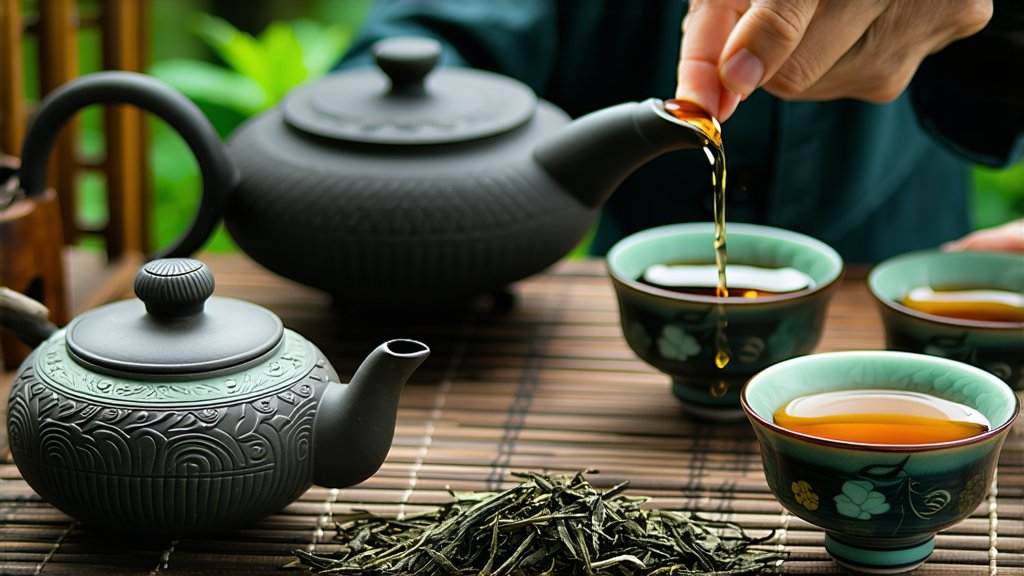
Pu-erh tea, a revered variety of Chinese dark tea hailing from the Yunnan province, boasts a history that spans over a thousand years. This unique tea has not only survived but thrived through centuries, becoming an integral part of China's rich cultural tapestry and gaining international acclaim for its distinctive flavor profile and health benefits.
Historical Background
The origins of Pu-erh tea can be traced back to the Tang Dynasty (618-907 AD), though it was during the Ming Dynasty (1368-1644 AD) that its production became more standardized. The name "Pu-erh" is derived from the market town of Pu'er in Yunnan, which served as a significant hub for tea trade along the ancient Tea Horse Road. This route facilitated the exchange of goods between various ethnic groups and played a crucial role in disseminating Pu-erh tea across Asia.
Types of Pu-erh Tea
Pu-erh tea is primarily categorized into two main types: raw (Sheng) and ripe (Shou). Raw Pu-erh undergoes natural fermentation over time, allowing it to develop complex flavors and aromas. In contrast, ripe Pu-erh is subjected to a controlled fermentation process known as "wet piling," which accelerates the aging process, resulting in a mellower taste and darker color. Both varieties offer unique sensory experiences that cater to different palates.
Production Process
The journey of Pu-erh tea begins with the careful selection of sun-dried Camellia sinensis leaves, typically from ancient tea trees found in the mountainous regions of Yunnan. These leaves are then steamed and rolled into various shapes, including cakes, bricks, and bowls, which aid in the tea's compression and long-term storage.
For raw Pu-erh, the leaves are piled up and left to age naturally, exposed to the elements, which allows microbial activity to gradually transform their characteristics. The ripening process can take several years, during which the tea develops earthy notes and a deep, robust flavor.
Ripe Pu-erh, on the other hand, undergoes a more accelerated fermentation process under controlled humidity and temperature conditions. This method mimics the natural aging process but within a shorter timeframe, producing a tea that is often described as having a smoother, more mellow taste compared to its raw counterpart.
Tasting and Appreciation
To truly appreciate Pu-erh tea, one must engage in a mindful tasting ritual that involves all the senses. Begin by observing the dry leaves and noting their shape, size, and color. Next, inhale the aroma deeply before brewing the tea in a Yixing clay pot or a Gaiwan, both traditionally favored for their ability to enhance the tea's flavors.
When brewing, use water just below boiling point (around 95°C or 203°F) to avoid scalding the delicate leaves. Steep the tea for about 10-30 seconds for the first infusion, gradually increasing the steeping time for subsequent infusions. Pu-erh tea is renowned for its ability to be re-steeped multiple times, each infusion revealing new layers of complexity.
As you sip, pay attention to the tea's mouthfeel, ranging from silky to astringent, and its evolving flavors, which can include notes of earth, wood, dried fruit, and even hints of floral undertones. The aftertaste, or "hui gan" (returning sweetness), is a hallmark of well-aged Pu-erh, leaving a pleasant, lasting impression on the palate.
Health Benefits
Beyond its captivating taste, Pu-erh tea has long been celebrated for its potential health benefits. It is believed to aid in digestion, promote weight loss, lower cholesterol levels, and improve cardiovascular health. Additionally, Pu-erh contains antioxidants that help combat free radicals, contributing to overall wellbeing.
Conclusion
Pu-erh tea is more than just a beverage; it embodies centuries of tradition, craftsmanship, and cultural significance. Its intricate production process, coupled with the art of tea appreciation, makes it a fascinating subject for exploration by tea enthusiasts worldwide. Whether you prefer the vibrant vitality of raw Pu-erh or the mellow depth of ripe Pu-erh, this ancient tea offers a gateway into the profound world of Chinese tea culture.